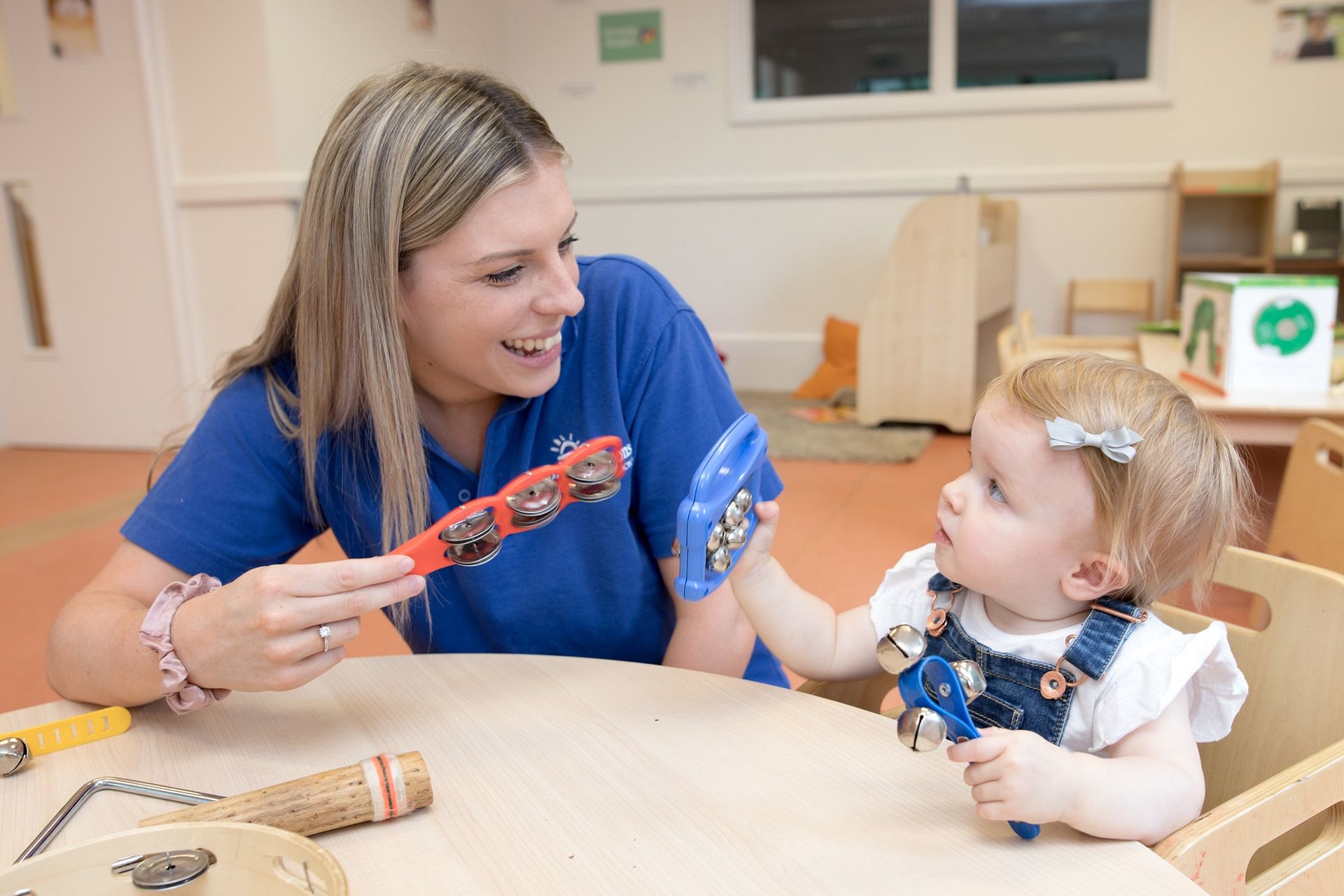Episode 4 - Literacy through Music
Early Years Podcast Episode 4
We’re singing and rhyming in this month’s episode! Caroline, our Director of Early Childhood, describes how music helps to develop early literacy. Discover key tips and techniques to try at home with your child. You might be surprised to hear how silly sounds and rhymes form the foundation for early reading.
Podcast Transcript
Fay – Hello and welcome to, or welcome back to, the Bright Horizons Early Years Podcast. My name is Fay, this is episode four, and today I’m joined by Caroline, who is our Director of Early Childhood. Hi, Caroline. Welcome to the podcast.
Caroline – Hello Fay, it’s lovely to be here. Thank you for inviting me.
Fay – Thank you for joining us. So, before we go into the topic today, could you tell us a little bit about your role at Bright Horizons?
Caroline – I am the Director of Early Childhood, which basically means that I provide the pedagogical steer for the whole of the Early Childhood team who go into the nurseries and support our practitioners with providing the very best care and learning opportunities for our children.
Fay – Excellent. I heard you mentioned there the word ‘pedagogical’. Could you quickly explain what that word means for us, in our practice, and for parents at home?
00:59:04
Caroline – Pedagogy is actually… it's a very old term. I think it's Greek, actually, but it means the art of teaching. So, very much the art of teaching as opposed to the science of teaching.
Fay – I definitely agree that teaching and caring for young children is an art form in itself! So, thank you for that definition.
Caroline – You’re welcome.
Fay – So I understand that your topic for today is how music can help children develop their early literacy skills.
Caroline – That's absolutely right. Yes, and I know that Amanda last month talked to us all about music for wellbeing, so this backs onto that really nicely.
Fay – Absolutely, and I understand that in our nurseries, when it comes to the early literacy side of things, we use specific techniques to help with children's development.
01:54:10
Caroline – We do indeed. We use a wonderful programme which is called Boogie Mites. Lots of lovely songs that are on the Boogie Mites disc, and they all have a very strong sense of rhythm and rhyme. Lots of different genres of music, so there's a bit of boogie and some typical children's songs, such as The Grand Old Duke of York and lots of new songs in there.
But the most important thing is that Boogie Mites helps children to tune in to the sounds of speech and music.
Fay – So what do you mean by ‘tuning in’?
02:37:00
Caroline – Tuning in: listening. Beginning to listen is really important. So we will do… I'm going to do some singing and I'm not a very good singer, so bear with me!
Fay – Well I look forward to it!
Caroline – But I think that's really another important thing, isn't it? We shouldn't be afraid to sing with children. Children enjoy the music. They're not judging our competency as a performer. And so we should all be confident to do our little bit.
So, for example, we would help children to tune in to the pitch of a sound. So we might say: [singing] Sing high, sing low.
And anyone can do that. And we would… when we introduce our music in the morning or whenever we're doing that session, we can encourage children to follow that and to copy us. Or we could listen to the tone of the music. Music has a tone, so it gives us a mood. So, for example, we could [singing] sing angry! Sing gentle.
And we can put whatever emphasis we want on that to help children to listen and to tune in to what the music is saying to us.
Because after all, if you can't hear and make sounds, then it's very difficult, later on, to read sounds and to put meaning into the sounds that you're reading. And also the loudness, the pitch is very important. So, for example, [singing] sing quiet, sing loud!
And children love all of that, of course, experimenting with their voices and really having fun singing as loud as they possibly can.
04:23:23
So as I said, not only does it help them to hear the sounds and to hear those different sounds, but also to make those sounds with their mouths. And we call that auditory discrimination. So it's discriminating sounds from a very early age. And we do that right from the very beginning. And all of this are essential elements of speech and later on the elements of reading.
04:50:23
Fay – Yeah. It sounds really interesting and that's obviously what we can do with the voices as well. What else can we do – and can parents at home do – in terms of other elements of the musicality? ‘Cause it's not just the voice, we have potentially instruments or tapping, don’t we? Things like that.
Caroline – Absolutely, we do, and singing really helps children to build their understanding of the rhythm of words. So how those words are made up. What are the similarities and differences? We want children to be able to hear the difference between sounds – and the similarity between sounds – such as ‘cat’ and ‘hat’.
Fay – Yep.
Caroline – And then bigger words such as ‘duster’, ‘muster’, ‘lustre’, and really helping children to make those connections by making up words – silly words, silly rhymes together – is great fun and we have lots of giggles along the way.
So, ‘Fairy Mary had a canary’, and all of those silly sort of rhymes. Children love those and they can be done when you've built your rhyme. So, ‘Fairy Mary had a canary’. You can then put a tune to it and it can be your own tune. So, we want children to play with those tunes and the words and those silly rhymes. That's a great thing to do at home.
And so particularly when you’re wandering down the street, talking about going to the shops, why not sing about going to the shops? What you're going to buy on your shopping list: [singing] Today we’re going to buy some cornflakes!
Just making fun with music is a really easy thing to do.
06:34:06
Fay – Yeah, I love that. My nan was a big fan of that as well. She always used to sing to me when I was younger and just, almost like in a musical, like you say, just singing about anything and taking that opportunity to build up your own rhythm, listen to the sounds, and then that can then later help with the reading, and hearing and understanding all the different parts that make up a word and then make up a sentence.
06:59:17
Caroline – It's really great fun and we do it all the time, don't you? Sometimes we do it without thinking about it. So we have tidy up songs, for example. I know as a mum I used to do the tidy up song with my little boy who now no longer is a little boy, unfortunately. But yeah, as you say, you know, doing it with your nan. I can remember having those lovely singing conversations together.
We also use musical instruments, of course, things such as shakers and drums and tapping sticks. And tapping sticks are a great, ‘cause we can just get those from the garden; we can use a couple of pencils, we can use a couple of wooden spoons or anything that you've got available.
And again, using tapping sticks to actually tap out the rhythm of words. So… because hearing a rhythm is absolutely key to be able to break down words into syllables, so that you can word build later on.
So one of the things that we do is to tap out the syllables in our name, for example, at the ‘hello song’ in the morning.
So it might be [singing and tapping] Ha-loh Fay, ha-loh Fay. Hal-loh Ca-ro-line.
And everybody can do that and the children love it. And gradually, as they become more used to hearing that, that tapping and breaking words down into syllables, that helps them to be able to recognise the rhythm within a word. And how a word is made up of different sounds.
08:33:09
Fay – Yep, I guess it also helps with those larger words as well. The longer words that have many syllables in and obviously sometimes, if children see those on a page, they can be a bit overwhelming at first, but then if they learn to break it down, then they might be able to say, ‘dev-el-lop-ment’, and get there in the end.
Caroline – Yeah, absolutely right Fay. The main thing really is to sing with your children. That's the ideal way to support reading readiness, just sing your favourite songs, as often as you can, and really get the children moving as well and dancing. It’s a really important facet of rhythm. You know, The Grand Old Duke of York is a lovely one, isn't it? He had ten thousand men, [singing] and he marched them up to the top of the hill and he marched them down again.
Fay – It’s got that strong beat.
Caroline – That real strong beat. So, it's a really simple thing that you can do. And as I said, you know, make up your own songs and have fun with words and rhythm and rhyme.
And of course, making musical instruments with your children at home is a great thing to do. It kills an hour or two for one thing! And then when you've got them, if you give them pride of place in a beautiful box that you've covered with sticky paper or wrapping paper, or a nice little basket that you've got or, you know, something special so that you can get them out every time you sing together.
09:48:50
But shakers are really easily made from the little empty water bottles. You can have different size ones, of course, so that you get different sounds as you shake, and maybe put some lentils or some chickpeas or some dried beans or something like that in the bottom. Make sure that you seal it up nice and tightly, of course, because, you know, we wouldn't want the children to take those items out. And listen to the sounds that they're making and shake them as you’re making them.
What different sounds can you make? Do the beans sound harder or louder maybe than the lentils? Try to find some words that describe the sounds. So, talk about hard sounds and soft sounds. What do the sounds remind you of? Do they sound like the trees blowing in the wind or the waves crashing on the beach? Again, it's all about that listening and differentiating and having fun, making these instruments together… and really listen to the difference.
If you can't hear the difference between rice or lentils in a bottle, how can you hear the difference between a ‘p’ and a ‘b’ or a ‘ch’.
The most important thing, I think, is just to have fun with music. As many different genres as we can introduce children to the better. And just being aware, all of the time, that what you're doing is really important and that it really is helping to build those neural pathways and to develop that auditory discrimination, which is so important for early reading.
11:44:21
Fay – Absolutely. Wow, we've covered a lot of ground, but thank you for coming along. And I feel like I've learned quite a bit about what we can do and especially sounding out those different letters and those different syllables in someone's name. Yeah, it's been brilliant. Thank you.
Caroline – You're very welcome. Thank you, Fay. It's been lovely talking to you, and if anybody's got any further questions about how music can support reading readiness, we'd be very happy to give them some more information, point them in right direction.
Fay – Perfect, yes, and indeed, we will. So, if you do have any questions at home, drop us an email or give us a phone call and let us know? Yes. Thank you, Caroline, for coming along today. And thank you to the rest of you listening at home. We look forward to seeing you on the next one!




